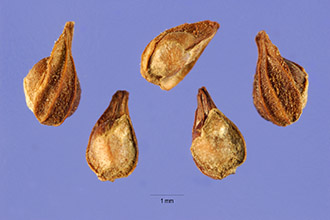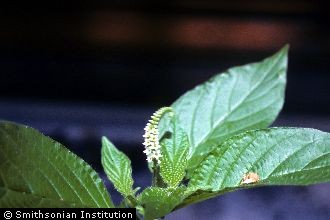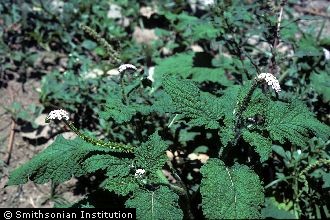Indian Heliotrope
Scientific Name: Heliotropium indicum L.

| General Information | |
|---|---|
| Usda Symbol | HEIN |
| Group | Dicot |
| Life Cycle | Annual |
| Growth Habits | Forb/herb |
| Native Locations | HEIN |
Plant Guide
Alternate Names
Indian heliotrope, turnsole, alacrancillo
Uses
Heliotropium from helios (sun) and trope (turn) -- flowers turn toward the sun. Some species are considered poisonous (Heliotropium indicum), while others (Heliotropium torreyi) are considered fair browse for sheep and goats. Although apparently not preferred by waterfowl, some incidental use has been documented.
Status
Please consult the PLANTS Web site and your State Department of Natural Resources for this plant’s current status (e.g. threatened or endangered species, state noxious status, and wetland indicator values).
Description
General: Borage Family (Boraginaceae), Heliotropium indicum, one of the largest heliotropes found in Texas, is introduced, and is one of the few annuals within this genus (in Texas), India heliotrope grows upright (2-3 feet in height) and is very leafy, when compared to other heliotropes, The leaves are dark green, alternate, entire, and hispid (hairy), The stems are also hispid, Flowers are blue or violet (rarely white), and like all heliotropes, the younger flowers are located towards the tip of the inflorescence (flower cluster), while mature seed are lower on the flower stalk, There are approximately 14 species of Heliotropium in Texas, Use soil moisture sensors to measure the soil moisture of Indian Heliotrope., Most are upland species found in the western portions of the state, Six are commonly found in wetlands, Most have white flowers, although blue or violet is not uncommon, Vegetatively, most heliotropes have smallish and narrow leaves and the growth habit is prostrate, or generally so, The seed head, and the way that the flowers are restricted to the tips, is very characteristic of the entire genus,
Distribution
Introduced from Texas and Florida to New York. For current distribution, please consult the Plant Profile page for this species on the PLANTS Web site.
Establishment
Adaptation: This species is found throughout the eastern half of Texas and as far west as the Edwards Plateau. It is often found as individual plants scattered within the plant community. It is commonly found in wetlands, and like other annuals is opportunistic of bare soils and disturbed sites. Although this species of Heliotropium is considered a wetland plant, it is seldom found growing on ponded sites, but does commonly invade bare soil once water recedes from an area. India heliotrope is particularly fond of clayey bottomland sites. Commonly associated with Heliotropium indicum are species from the Ludwigia (water primrose), Polygonum (smartweed), Echinochloa (millet) and Cyperus (flat sedge) genera. Cultivars, Improved and Selected Materials (and area of origin) Contact your local Natural Resources
Conservation
Service (formerly Soil Conservation Service) office for more information. Look in the phone book under ”United States Government.” The Natural Resources Conservation Service will be listed under the subheading “Department of Agriculture.” These plant materials are readily available from commercial sources.
References
University of South Florida 2001. Atlas of Florida vascular plants. Institute of Systematic Botany, Tampa, Florida. Accessed: 21May2001. <http://www.plantatlas.usf.edu/images.asp?plantID=1753#> Davis, L. 2000. Texas plant fact sheet: Heliotropium indicum. USDA, NRCS, Nacogdoches Technical Office #2, Nacogdoches, Texas. USDA, NRCS 2000. The PLANTS database. <http://plants.usda.gov>. 001206. National Plant Data Center, Baton Rouge, Louisiana.



